- About
- Members
- Join
- Member log in
- Membership Renewal
- Member directory
- Life Members
- ASPS Life Member Professor Graham Farquhar
- ASPS Life Member Associate Professor Hendrik (Hank) Greenway
- ASPS Life Member Dr Marshall (Hal) D Hatch
- ASPS Life Member Dr Paul E Kriedmann
- ASPS Life Member Dr Mervyn Ludlow
- ASPS Life Member Emeritus Professor Rana Munns
- ASPS Life Member Conjoint Professor Christina E Offler
- ASPS Life Member Professor (Charles) Barry Osmond
- ASPS Life Member Emeritus Professor John W Patrick
- ASPS Life Member Dr Joe Wiskich
- Corresponding Members
- Elected Fellows
- Events
- Awards & Funding
- Employment
- Publications
- Research
- Teaching
- Menu
ACT Mass Spectrometry Symposium 2017
07 November 2017
THE FULL PROGRAM AND FREE REGISTRATION ARE NOW OPEN for:
ACT Mass Spectrometry Symposium 2017, Tuesday November 28, 2017.
Get in QUICKLY because seats a strictly limited!
Description
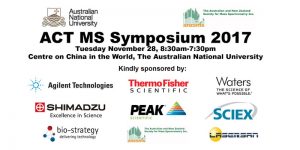 The ACT Mass Spectrometry Symposium is intended as an interactive forum for experts and novices to discuss the application of mass spectrometry to solving problems and to allow the dissemination of current and future trends in the technology. The speakers represent academic and commercial backgrounds and will cover a wide range of applications as can be seen in the programme below.
The ACT Mass Spectrometry Symposium is intended as an interactive forum for experts and novices to discuss the application of mass spectrometry to solving problems and to allow the dissemination of current and future trends in the technology. The speakers represent academic and commercial backgrounds and will cover a wide range of applications as can be seen in the programme below.
Programme
8:55 am WELCOME
9:05 am Clayton Ross (Shimadzu):
Shimadzu GCMS TQ-8050 – Speed Without Compromise (Simultaneous MRM, SIM and SCAN)
9:30 am David DeSouza (Metabolomics Australia, VIC):
Comprehensive Metabolite Profiling by GC-QQQ: A Change in Approach
9:55 am Chris Fouracre (Agilent Technologies):
Revealing the New Ultivo Triple Quadrupole LC/MS
10:20 am David Beale (CSIRO Land & Water, QLD):
Expanding Characterization of Environmental Pollution and Ecosystem Health Using Metabolomic Approaches
10:45 am MORNING TEA BREAK
11:15 am Steve Binos (Thermo Fisher):
Orbitrap DIA; Beyond ID’s for your Proteomic Needs.
11:40 am Rikard Hedman (ANU Research School of Chemistry, ACT):
Detection of Sulfate Conjugated Compounds by Untargeted Mass Spectrometry
12:05 pm Nicole Pendini (Peak Scientific):
Gas Generators: the Safe Onsite Alternative to Cylinders and Dewars
12:30 pm LUNCH BREAK
1:30 pm Chris Hodgkins (AB Sciex):
SelexION®+; Improving Triple-Quadrupole Selectivity with Differential Mobility Spectrometry (DMS) to Reach Lower Limits of Quantitation.
1:55 pm Steve Van Sluyter (Macquarie University, NSW):
Absolute Quantification of Leaf Proteins on a Continental Scale Using SWATH
2:20 pm Heather Patsiouras (Waters):
Ion Mobility MS: Extending the Capability and Selectivity of MS
2:45 pm AFTERNOON TEA BREAK
3:00 pm Udo Rupprecht (Lasersan):
On-line Automated Sample Preparation for GC/MS and LC/MS
3:25pm John Foster (ANU Research School of Earth Sciences, ACT):
Development of Shrimp Ion Microprobe
3:50 pm Alex Donald (University of NSW School of Chemistry, NSW):
Highly Charged Protein Ions: The Strongest Acids to Date
4:15 pm Awards and Announcements
4:30-7:30 pm POST-SYMPOSIUM DRINKS and NIBBLES
For More Information contact Adam Carroll
ASPS Travel Award Report Recipient Hones Presentation Skills at ComBio2017
18 October 2017
By
Viviana Rosati
Thanks to an ASPS Travel Award, I was able to attend the ComBio2017 conference this October in Adelaide, South Australia. It was personally and professionally fulfilling not only to be attending, but presenting, at my very first ComBio. The conference is the main forum for the Australian Society for Biochemistry and Molecular Biology (ASBMB), the Australia and New Zealand Society for Cell and Developmental Biology (ANZSCDB), and the Australian Society of Plant Scientists (ASPS), with the societies coming together for three days to promote the latest in research and education, as well as enable invaluable network opportunities.
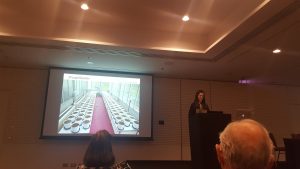 For me, a highlight of the conference was the plenary Annals of Botany Lecture on the second day featuring Professor Cathie Martin from the John Innes Centre. Professor Martin works to increase polyphenol phytonutrients in fruits: compounds with therapeutic properties that could potentially mitigate artherosclerosis and other inflammatory conditions. She emphatically stated: ‘Medicine is not healthcare, food is healthcare. Medicine is sickcare’ – an appropriate reminder for us all.
For me, a highlight of the conference was the plenary Annals of Botany Lecture on the second day featuring Professor Cathie Martin from the John Innes Centre. Professor Martin works to increase polyphenol phytonutrients in fruits: compounds with therapeutic properties that could potentially mitigate artherosclerosis and other inflammatory conditions. She emphatically stated: ‘Medicine is not healthcare, food is healthcare. Medicine is sickcare’ – an appropriate reminder for us all.
Over the next two days I attended an array of symposia including: Plant Energy Use Efficiency, Next-generation Phenotyping, Plant Walls and Membranes, Abiotic Stress Tolerance, Microbe-Plant Interactions, and Plant Reproductive Biology. All talks gave me vital insight into the current plant biology research being undertaken worldwide, and offered me several new avenues for my own research – particularly techniques to elucidate the molecular regulation of genes involved in emerging regulatory pathways. The conference delivered an impressive balance of graduate students, post-doctoral researchers, associate professors, and professors presenting their cutting-edge research or stories of discovery.
As part of the crop productivity symposium, I presented my research topic Drought Response in Low-Cyanogenic Sorghum bicolor Mutants; with the presentation being very well received. I took a number of questions during the allocated question time and was given valuable advice driving new exploration within the scope of my research program. It is now the fourth time within a two-year period that I have been a conference presenter. As one might expect, my confidence grows with each presentation and as I become more adept; and there is always a constant challenge to improve and hone my skills in order to deliver a story with a clear message that engages interest and drives impact.
I am extremely grateful to ASPS for providing funding that enabled me to attend the conference and present my research to the plant science community.
Contact: Viviana Rosati (viviana.rosati@monash.edu)
41st New Phytologist Symposium: Plant sciences for the future
18 October 2017
Registration now open!
41st New Phytologist Symposium: Plant sciences for the future
11–13 April 2018, Nancy, France
https://www.newphytologist.org/symposia/41
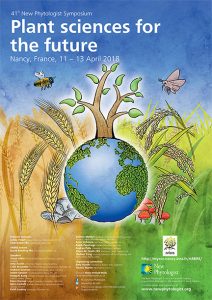 The 41st New Phytologist Symposium will provide new insights into the evolutionary forces and molecular mechanisms that govern plant development and physiology, and their interactions with biotic and abiotic cues.
The 41st New Phytologist Symposium will provide new insights into the evolutionary forces and molecular mechanisms that govern plant development and physiology, and their interactions with biotic and abiotic cues.
Invited speakers from the New Phytologist Editorial Board will highlight emerging topics in plant sciences as well as the application of modern technologies to capture the complex mechanisms driving plant development, physiology, interactions and evolution.
Eighteen leading scientists will speak at the symposium along with early career researchers, selected to give talks following submission of poster abstracts. Travel grants are available.
Travel grant deadline: Thursday 18 January 2018
Poster abstract deadline: Thursday 8 February 2018
More details and registration at https://www.newphytologist.org/symposia/41.
Science Meets Parliament 2017 – optimistic futures for plant scientists
12 October 2017
By
ARC DECRA Fellow, School of Agriculture, Food and Wine
Waite Campus, University of Adelaide
Science Meets Parliament is an annual event of Science and Technology Australia (STA) bringing together 200 of Australia’s leading scientists and technologists to Canberra. This professional gathering stimulates and inform parliamentarians of how science contributes to our society and aims to inform public policy, and; to assist in professional development through providing participants with an insight into political, policy, media and parliamentary processes.
Australian Society of Plant Scientists gave me a wonderful opportunity to be a part of science meets parliament during March 2017. The event enabled me to get to know the views of some Australia’s most influential and passionate parliamentarians, science advisors, STEM professionals and media personalities.
Day one is all about professional development, building connections and collaborations . We were provided with useful tips on how to turn science into news, how science is used to shape public policy, how to convince a parliamentarian without using the word money or funding, and how to pitch my science in 60 seconds. I really felt optimistic about my future as a plant scientists after listening to the commitment of the government to further advance science and technology in years to come.
On day two, I met Hon Senators Chris Back and Chris Ketter face-to-face in their parliament office. I was really impressed by the way they listened and interacted with me to learn more about how grow crops can grow in salty soils. I was also inspired by the parliamentary speeches and organised forums during parliament. In particular, a glowing endorsement of curiosity driven by research undertaken by Professor Alan Mackay-Sim, Australian of the Year, resonated with me even after the completion of the event.
I also participated a breakfast event organised by the University of Adelaide’s external relations branch on day three which allowed me to interact as well as promote science and build new connections with South Australian parliamentarians and alumni.
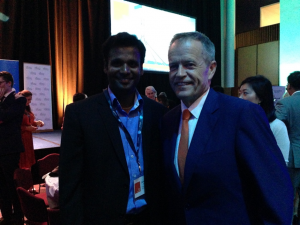
Dr Jayakumar Bose, ASPS representative, and Hon Bill Shorten MP, and Leader of the Opposition at the Science Meets Parliament 2017 at the Great Hall of the Australian Parliament House in Canberra.
Contact Information: Jayakumar Bose (jayakumar.bose@adelaide.edu.au)
The different flavours of when Science meets Parliament
05 October 2017
By Florian Busch from the Australian National University, Canberra, ACT
During March 2017, parliament in Canberra became flooded with scientists of all kinds of flavours for two days as Science met Parliament in this annual event. This event aims at increasing the dialogue between politicians and scientists to increase the awareness and understanding of how STEM can drive Australia’s economic, social, environmental, and cultural future. I was lucky to be picked as one of two early/mid-career plant scientists representing the Australian Society of Plant Scientists. The two days were filled with quite unique experiences, including a full day of career development and preparation for meeting the parliamentarians, and then, of course, one big day in Parliament.
Australia’s Chief Scientist Dr. Alan Finkel opened the first day setting the scene for what to expect. This was followed by sessions on how science is turned into news and used to shape policy. The focus of the day, however, was on how to make the most of the little time we had for our meeting with the parliamentarians. How much science background could we expect? How detailed should we present our work during our meeting with the parliamentarians? In preparation, we paired up in small groups to practice our ‘elevator pitch’, where we were challenged to explain the nuances of our work in a minute or two, to people outside our fields of expertise. My major lesson from this exercise was discovering the fast pace at which politicians move from one topic to the next. This also turned out to be a great networking opportunity, allowing me to meet scientists from diverse fields of research across all of Australia. The highlight of the day, however, was a gala dinner at Parliament House, where we heard from the newly minted Minister for Industry, Innovation and Science, The Hon Arthur Sinodinos, and the Leader of the Opposition, The Hon Bill Shorten, as how they might envision science in future politics.
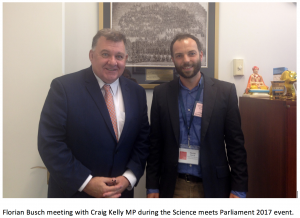 On the second day, we were inspired by Australian of the Year, Prof. Alan Mackay-Sim, and had the chance to meet the Shadow Minister, The Hon Kim Carr. Lunch was broadcast live on TV at the National Press Club, where the Minister for Industry, Innovation and Science was grilled with questions from the press. The definite highlight of the day was meeting our parliamentarians. I was paired up with two other scientists to meet with MP Craig Kelly. This is when practicing our ‘elevator pitch’ the day before paid off; I only had a few minutes to discuss the role of photosynthesis research in securing food production before MP Craig Kelly ran off to his next meeting. He left us with a deep impression of how parliament works and, hopefully, we left him with some insights into how science works and can shape the economy.
On the second day, we were inspired by Australian of the Year, Prof. Alan Mackay-Sim, and had the chance to meet the Shadow Minister, The Hon Kim Carr. Lunch was broadcast live on TV at the National Press Club, where the Minister for Industry, Innovation and Science was grilled with questions from the press. The definite highlight of the day was meeting our parliamentarians. I was paired up with two other scientists to meet with MP Craig Kelly. This is when practicing our ‘elevator pitch’ the day before paid off; I only had a few minutes to discuss the role of photosynthesis research in securing food production before MP Craig Kelly ran off to his next meeting. He left us with a deep impression of how parliament works and, hopefully, we left him with some insights into how science works and can shape the economy.
Contact: Florian Busch (florian.busch@anu.edu.au) for further enquires.
Early career plant scientists! Your CV needs a Tansley Medal
28 September 2017
Calling all early career plant scientists!
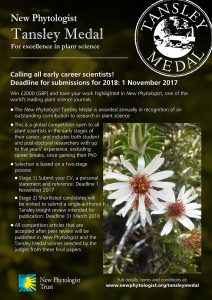 The New Phytologist Tansley Medal is awarded annually in recognition of an outstanding contribution to plant science by an early career researcher (student and post-doctoral researchers with up to five years’ experience since gaining/defending their PhD are eligible). The winner will receive a prize of £2000 (GBP) and will author a Tansley insight review that will be published in New Phytologist, accompanied by an Editorial announcing the winner and finalists. The application deadline for this year’s competition is 1 November 2017.
The New Phytologist Tansley Medal is awarded annually in recognition of an outstanding contribution to plant science by an early career researcher (student and post-doctoral researchers with up to five years’ experience since gaining/defending their PhD are eligible). The winner will receive a prize of £2000 (GBP) and will author a Tansley insight review that will be published in New Phytologist, accompanied by an Editorial announcing the winner and finalists. The application deadline for this year’s competition is 1 November 2017.
The Tansley Medal award is an opportunity to recognise an outstanding scientist in the early stages of their career, and supporting the next generation of plant scientists is one of the main activities of the New Phytologist Trust. Please support us in this endeavour by spreading the word to anyone you know who might be eligible to apply for the Tansley Medal award. If you have any queries regarding the medal or the submission process please do not hesitate to get in touch. More details on the Tansley Medal can be found at: https://www.newphytologist.org/tansleymedal.
The impact of drought on Australian pulse crops
05 April 2017
ASPS poster award winner Michael Dodt tells a story about his success at COMBIO 2016
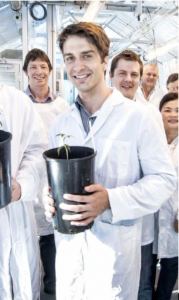 My PhD research has focussed on improving our understanding of the impact that drought stress has on Australian pulse crops. My research mainly revolves around four areas of study: photosynthetic responses to drought, root morphology / architecture; crop modelling (APSIM) and transcriptomics (RNA-Seq). A major part of my project has been establishment and evaluation of a novel chemical seed pre-treatment to enhance root development of commercial crops for improved drought tolerance. This fits into our team’s larger project aimed at improving biotic and abiotic stress tolerance of a range of crop species as well as improving nutritional value of crops. I was fortunate enough to have the opportunity to present at COMBIO in 2016 and was thrilled to win the best poster award. COMBIO provided an excellent opportunity to gain experience presenting at a conference and I highly recommend it to all early career researchers – especially if you’re nervous about presenting. This is a great opportunity to gain exposure and confidence in the scientific community. It is an excellent event for PhD students since it’s big and broad enough to fit in comfortably while networking with top tier scientists from multiple disciplines. Speakers were fantastic and there were plenty of opportunities for interaction. I look forward to my next opportunity.
My PhD research has focussed on improving our understanding of the impact that drought stress has on Australian pulse crops. My research mainly revolves around four areas of study: photosynthetic responses to drought, root morphology / architecture; crop modelling (APSIM) and transcriptomics (RNA-Seq). A major part of my project has been establishment and evaluation of a novel chemical seed pre-treatment to enhance root development of commercial crops for improved drought tolerance. This fits into our team’s larger project aimed at improving biotic and abiotic stress tolerance of a range of crop species as well as improving nutritional value of crops. I was fortunate enough to have the opportunity to present at COMBIO in 2016 and was thrilled to win the best poster award. COMBIO provided an excellent opportunity to gain experience presenting at a conference and I highly recommend it to all early career researchers – especially if you’re nervous about presenting. This is a great opportunity to gain exposure and confidence in the scientific community. It is an excellent event for PhD students since it’s big and broad enough to fit in comfortably while networking with top tier scientists from multiple disciplines. Speakers were fantastic and there were plenty of opportunities for interaction. I look forward to my next opportunity.
Email: michaeldodt1@gmail.com
Centre for Tropical Crops and Biocommodities, QUT, Brisbane.
Sambasivam Periyannan – 2016 ASPS Peter Goldacre Award recipient shares his story of success
09 March 2017
SECURING GLOBAL FOOD PRODUCTION BY
RAPID ISOLATION OF WHEAT RUST DISEASE RESISTANCE GENES
Born and raised among the tropical plants on a small farm in Southern India, I never dreamed of becoming a researcher instead of a farmer. With a Master’s in Plant Pathology and a short exposure to the management of diseases in horticultural crops, in 2007, I had the opportunity to migrate to Australia to undertake a PhD at Plant Breeding Institute (PBI), University of Sydney. Until the time, I didn’t realise that PBI is the pioneering centre for fundamental studies on plant-pathogen interactions. With the outbreak of the deadly stem rust fungus Ug99 in East Africa, my PhD project was specifically focused on the molecular genetics of wheat stem rust resistance. At PBI, I was working with Drs Harbans Bariana and Urmil Bansal who are world renowned expertise in identifying and charateristing novel rust resistance genes in wheat. With a year of training on rust pathogenicity, in 2008, I moved to Dr Evans Lagudah’s lab at CSIRO, Canberra to continue the project towards rust resistance gene cloning. I was so excited to join Evan’s lab as it is one among the very few labs of the world which are successful in cloning rust disease resistance genes from the complex wheat genome. Given the complex nature of the wheat genome, it was a challenging project for PhD training. But with emergence of Ug99 as a major threat to global food security, I was highly motivated to succeed and I cloned the first stem rust resistance gene Sr33 from wheat. Further enthusiasm came when the results were published in Science (with cover page highlights) capturing the attention of several media outlets including BBC news (http://www.bbc.com/news/science-environment-23084782).
Du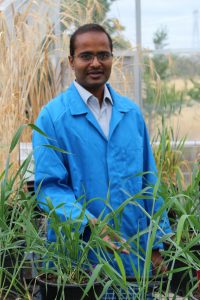 ring that time, I realised that the wheat and the plant science community as a whole was in need of a robust method for isolating disease resistance genes as the conventional map-based gene cloning was tedious and time consuming. Using the resources of Sr33 and in collaboration with Drs Brande Wulff (at John Innes Centre) and Jonathan Jones’ lab (The Sainsbury Laboratory) at Norwich (UK), a rapid resistance gene cloning tool called “Mutagenesis and Resistance gene enrichment and Sequencing (MutRenSeq)” was developed to identify resistance genes within two years, whilst the map-based approach on average requires five years. This new technology was further validated by the successful isolation of two additional stem rust resistance genes, Sr22 and Sr45, which like Sr33, were effective against Ug99 and other wheat stem rust races. Along with the publication of this method in Nature Biotechnology (as a cover page article), the technique holds a patent in the USA. Apart from wheat, this robust gene cloning technique is currently being extended to other agricultural crops such as barley, soybean, potato, tomato and rye.
ring that time, I realised that the wheat and the plant science community as a whole was in need of a robust method for isolating disease resistance genes as the conventional map-based gene cloning was tedious and time consuming. Using the resources of Sr33 and in collaboration with Drs Brande Wulff (at John Innes Centre) and Jonathan Jones’ lab (The Sainsbury Laboratory) at Norwich (UK), a rapid resistance gene cloning tool called “Mutagenesis and Resistance gene enrichment and Sequencing (MutRenSeq)” was developed to identify resistance genes within two years, whilst the map-based approach on average requires five years. This new technology was further validated by the successful isolation of two additional stem rust resistance genes, Sr22 and Sr45, which like Sr33, were effective against Ug99 and other wheat stem rust races. Along with the publication of this method in Nature Biotechnology (as a cover page article), the technique holds a patent in the USA. Apart from wheat, this robust gene cloning technique is currently being extended to other agricultural crops such as barley, soybean, potato, tomato and rye.
With the above achievements, I was fortunate to win the prestigious ASPS “Peter Goldacre Award”. This award contributed to my success in winning a highly competitive Australian Research Council “Discovery Early Career Researcher Award”. My gratitude for both awards has fuelled my hunger for future research success, where I am now identifying the signalling elements and molecular pathways of the cloned rust resistance genes in pathogen infected wheat. As plant pathogens evolve rapidly and become a major problem for securing food production and sustainable agriculture, knowledge of disease resistance gene function is required to help innovate a new generation of robust crops with durable resistance to multiple pathogen varieties.
I would like to acknowledge Sydney University, ACIAR, Durable Rust Resistance in Wheat project and Grains Research and Development Corporation for the scholarship and the research grant to undertake the aforementioend studies. Finally, I thank Drs TJ Higgins, Jeff Ellis and Evans Lagudah at CSIRO for nominating me for the prestigous ASPS Goldacre Award.
Email: Sambasivam.Periyannan@csiro.au
References:
- Steuernagel B#, Periyannan S#, Hernandez-Pinzon I, Witek K, Rouse M, Yu G, Hatta A, Ayliffe M, Bariana H, Jones J, Lagudah E, Wulff B (2016). Rapid cloning of disease-resistance genes in plants using mutagenesis and sequence capture. Nature Biotechnology 34:652-655 ( #joint first author)
- Periyannan S, Moore J, Ayliffe M, Bansal U, Wang X, Huang L, Deal K, Luo M, Kong X, Bariana H, Mago R, McIntosh R, Dodds P, Dvorak J, Lagudah E(2013).The gene Sr33, an ortholog of barley Mla genes, encodes resistance to wheat stem rust race Ug99. Science 341:786-788.
Cyclotides: small plant defence molecules to drive pharmaceutical innovation
01 February 2017
COMBIO 2016 winner of the ASPS Student Poster Awards
Georgianna Oguis
Institute for Molecular Bioscience – University of Queensland, Australia
Plants have evolved quite a number of ways to evade predators. An obvious strategy for an organism incapable of rapid movement out of danger is to produce toxins. Whilst the most notable plant defence molecules are small molecule secondary metabolites, there exists great many peptides that are also expressed in plants. One such class of these peptides are known as cyclotides, and these have special properties worth talking about. The discovery of cyclotides goes back to 1973 when Norwegian doctor Lorents Gran discovered that the active ingredient of the herbal tea African women drink in order to induce birth is apparently an ultrastable peptide that can survive boiling and oral ingestion1. Gran named the molecule kalata B1—after the local name of the plant kalata-kalata (Oldenlandia affinis). Since then many other cyclotide-related studies spawned. However, it was only in 1999 that the term “cyclotide” was coined; and these specifically pertain to head-to-tail cyclised plant peptides which have three disulfide bridges that are arranged to form a knotted topology2. Cyclotides are found to exhibit a range of biological activities including anthelminthic, cytotoxic, molluscicidal and antimicrobial activities3. Other than these, cyclotides have very promising applications both in agriculture and in peptide-based therapeutics—the former being the hypothesised evolutionary role as an insecticide and the latter which can be attributed to their ultrastable properties (brought about by its cyclic structure and knotted topology), thus be used as frameworks for peptide drug engineering.
Before the year concluded in 2016, the first cyclotide-based bioinsecticide called Sero-X was made commercially available. The product was developed and is being manufactured by the Australian-owned company InnovateAg. The insecticide is currently being applied to control pests on cotton and macadamia crops. Although there are yet no cyclotide-based peptide therapeutics on the market, the possibility of this scaffold appearing in a commercial product may not be that far off as several proofs of the concept have already been published3. The main idea behind this is to “graft” or replace a number of native cyclotide amino acids with specific sequences which can target cancer cells, adipocytes, cell receptors, and possibly many other targets. By having these sequences grafted into the cyclotide scaffold, we are able to create ultrastable peptide therapeutics that are highly specific and would not interfere with healthy cells. There is repeated emphasis on “ultrastability”, as this property is essential to improved peptide drug delivery and half-life. A particular peptide-based drug may be stable in vitro but when administered in vivo, an entire array of enzymes, compounds, acids and proteases plus the non-optimal environment can encumber peptide function, or lead to degradation. Another good point, or perhaps one of the best points of cyclotides, is that they are naturally produced in plants. This implies that we can utilise plants as biofactories for the production of these cyclotide-based therapeutics. The advantage of this plant-based system is that we are able to cheaply produce medicines in large quantities, making them affordable to all walks of life, especially to people in developing countries who will finally be given VIP access to life’s basic necessities.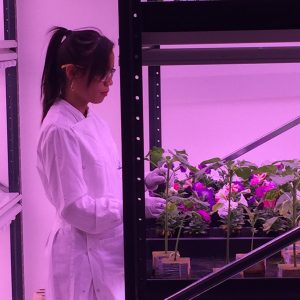
My winning poster entry at ComBio 2016 entitled “The key drivers of cyclotide production in butterfly pea” is but a glimpse of a very big picture. I am part of a big group headed by Prof. David Craik, the driver of research in the areas of cyclotide therapeutic and plant biosynthesis of cyclotides. I would love to think of our group as a factory where we are categorised into several subgroups that are unified with a goal. For instance, the chemists and structural biologists synthesise and characterise the peptides. The cell biologists and biochemists subsequently test these peptides in vitro and in vivo. The molecular biologists and plant scientists then express the peptides of interest into the plants for possible mass production. I happened to be sitting at the end of the chain where my colleagues and I try to establish an optimised system for the production of pharmaceuticals in plants. The poster features one of the many aspects of production in plants we are looking at. In a nutshell, I want to know what drives cyclotide production in butterfly pea (Clitoria ternatea), as this specific plant expresses chemically diverse cyclotides in all life stages and in such great abundance. Once I have characterised the key drivers, I can potentially use these to drive the production of cyclotide-based pharmaceuticals in other plant systems that are economically important. In other words, we need to identify the best driver to race the fastest car in a professional team, and hopefully cross that finish line first to bag the golden trophy.
References:
1 Gran L. On the effect of a polypeptide isolated from “Kalata-Kalata” (Oldenlandia affinis DC) on the oestrogen dominated uterus. Acta Pharmacol Toxicol. 1973;33:400–8.
2 Craik DJ, Daly NL, Bond T,Waine C. Plant cyclotides: a unique family of cyclic and knotted proteins that defines the cyclic cystine knot structural motif. J Mol Biol. 1999;294:1327–36.
3 Oguis GK, Kan MW, Craik DJ. Natural functions and structure-activity relationships of cyclotides. Adv Bot Res. 2015;76: 187-226.
Contact: Georgianna Oguis @ g.oguis@imb.uq.edu.au
Recent Posts
Tags
Archives
- June 2025
- May 2025
- April 2025
- March 2025
- February 2025
- January 2025
- December 2024
- November 2024
- October 2024
- September 2024
- August 2024
- July 2024
- June 2024
- May 2024
- April 2024
- February 2024
- January 2024
- November 2023
- October 2023
- September 2023
- August 2023
- July 2023
- June 2023
- May 2023
- April 2023
- March 2023
- February 2023
- December 2022
- November 2022
- October 2022
- September 2022
- August 2022
- July 2022
- June 2022
- May 2022
- April 2022
- March 2022
- February 2022
- January 2022
- December 2021
- November 2021
- October 2021
- September 2021
- August 2021
- July 2021
- June 2021
- April 2021
- March 2021
- February 2021
- January 2021
- December 2020
- November 2020
- October 2020
- September 2020
- August 2020
- July 2020
- June 2020
- May 2020
- April 2020
- March 2020
- February 2020
- January 2020
- December 2019
- November 2019
- October 2019
- September 2019
- August 2019
- July 2019
- June 2019
- May 2019
- April 2019
- March 2019
- February 2019
- January 2019
- December 2018
- November 2018
- October 2018
- September 2018
- August 2018
- July 2018
- June 2018
- May 2018
- April 2018
- March 2018
- February 2018
- January 2018
- December 2017
- November 2017
- October 2017
- September 2017
- August 2017
- July 2017
- June 2017
- May 2017
- April 2017
- March 2017
- February 2017
- January 2017
- December 2016
- November 2016
- October 2016
- September 2016
- August 2016
- July 2016
- June 2016
- May 2016
- April 2016
- March 2016
- February 2016
- January 2016
- December 2015
- November 2015
- October 2015
- September 2015
- August 2015
- July 2015
- June 2015
- May 2015
- April 2015
- March 2015
- February 2015
- January 2015
- December 2014
- November 2014
- October 2014
- September 2014
- August 2014
- July 2014
- June 2014
Copyright 2017 Australian Society of Plant Scientists Disclaimer & Privacy
Website by Michael Major Media
